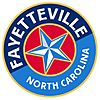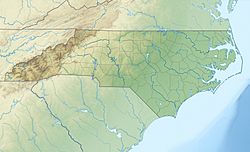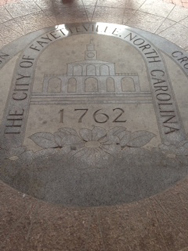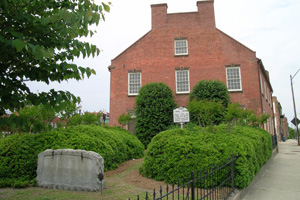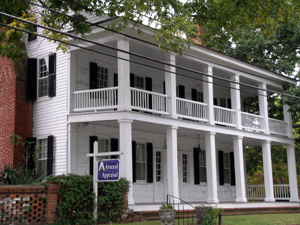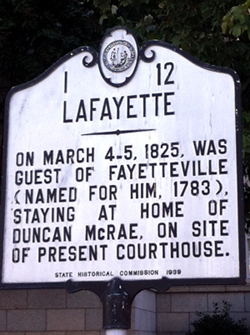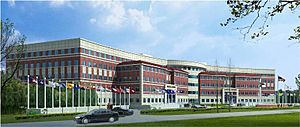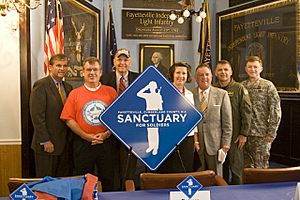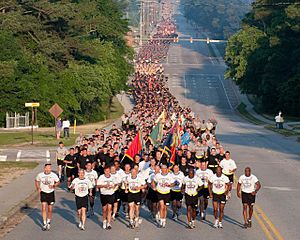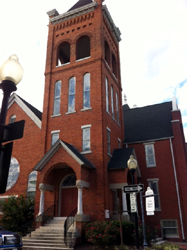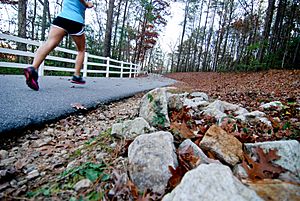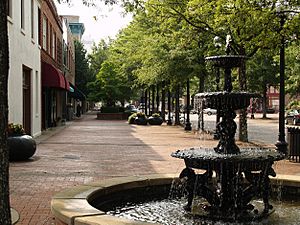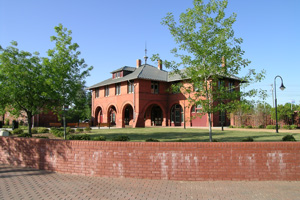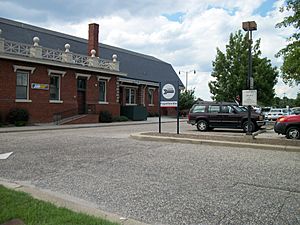Fayetteville, North Carolina facts for kids
Quick facts for kids
Fayetteville
|
|||||
|---|---|---|---|---|---|
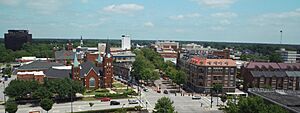
Downtown Fayetteville
|
|||||
|
|||||
| Nicknames:
America's Can Do City, All-American City, City of Dogwoods, Fayettenam, The Ville, 2-6, The Soldier City
|
|||||
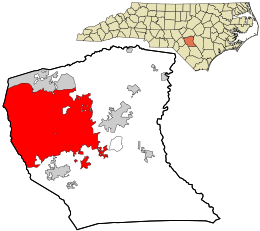
Location in Cumberland County and North Carolina
|
|||||
| Country | United States | ||||
| State | North Carolina | ||||
| County | Cumberland | ||||
| Settled | 1783 | ||||
| Named for | Gilbert du Motier, Marquis de Lafayette | ||||
| Government | |||||
| • Type | Council-Manager | ||||
| Area | |||||
| • Total | 150.08 sq mi (388.71 km2) | ||||
| • Land | 148.26 sq mi (383.99 km2) | ||||
| • Water | 1.82 sq mi (4.73 km2) 1.21% | ||||
| Elevation | 223 ft (68 m) | ||||
| Population
(2020)
|
|||||
| • Total | 208,501 | ||||
| • Estimate
(2023)
|
209,749 | ||||
| • Rank | 110th In the United States 6th in North Carolina |
||||
| • Density | 1,406.34/sq mi (542.99/km2) | ||||
| • Urban | 325,008 (US: 125th) | ||||
| • Urban density | 1,658.8/sq mi (640.5/km2) | ||||
| • Metro | 392,336 (US: 142nd) | ||||
| Time zone | UTC−5 (Eastern (EST)) | ||||
| • Summer (DST) | UTC−4 (EDT) | ||||
| ZIP code |
28301, 28302, 28303, 28304, 28305, 28306, 28307 (Fort Liberty), 28308 (Pope AAF), 28309, 28310 (Fort Liberty), 28311, 28312, 28314
|
||||
| Area codes | 910, 472 | ||||
| FIPS code | 37-22920 | ||||
| GNIS feature ID | 2403604 | ||||
| Primary Airport | Fayetteville Regional Airport | ||||
| Public transportation | Fayetteville Area System of Transit | ||||
Fayetteville (/ˈfeɪətvɪl, ˈfɛdvɪl/ FAY-ət-VIL-,_-FED-vil) is a city in and the county seat of Cumberland County, North Carolina, United States. It is best known as the home of Fort Liberty, a major U.S. Army installation northwest of the city.
Fayetteville has received the All-America City Award from the National Civic League three times. As of the 2020 census, it had a population of 208,501, It is the 6th-most populous city in North Carolina. Fayetteville is in the Sandhills in the western part of the Coastal Plain region, on the Cape Fear River.
With an estimated population of 392,336 in 2023, the Fayetteville metropolitan area is the second-most populous in southeastern North Carolina and 142nd-most populous in the United States. Suburban areas of metro Fayetteville include Fort Liberty, Hope Mills, Spring Lake, Raeford, Pope Field, Rockfish, Stedman, and Eastover.
Contents
History
Early settlement
The area of present-day Fayetteville was historically inhabited by various Siouan Native American peoples, such as the Eno, Shakori, Waccamaw, Keyauwee, and Cape Fear people. They followed successive cultures of other indigenous peoples in the area for more than 12,000 years.
After the violent upheavals of the Yamasee War and Tuscarora Wars during the second decade of the 18th century, the North Carolina colony encouraged English settlement along the upper Cape Fear River, the only navigable waterway entirely within the colony. Two inland settlements, Cross Creek and Campbellton, were established by Scots from Campbeltown, Argyll and Bute, Scotland.
Merchants in Wilmington wanted a town on the Cape Fear River to secure trade with the frontier country. They were afraid people would use the Pee Dee River and transport their goods to Charleston, South Carolina. The merchants bought land from Newberry in Cross Creek. Campbellton became a place where poor whites and free blacks lived, and gained a reputation for lawlessness.
In 1783, Cross Creek and Campbellton united, and the new town was incorporated as Fayetteville in honor of Gilbert du Motier, Marquis de Lafayette, a French military hero who significantly aided the American forces during the war. Fayetteville was the first city to be named in his honor in the United States. Lafayette visited the city on March 4 and 5, 1825, during his grand tour of the United States.
American Revolution
The local region was heavily settled by Scots in the mid/late 1700s, and most of these were Gaelic-speaking Highlanders. The vast majority of Highland Scots, recent immigrants, remained loyal to the British government and rallied to the call to arms from the Royal Governor. Despite this, they were eventually defeated by a larger Revolutionary force at the Battle of Moore's Creek Bridge. The area also included a number of active Revolutionaries.
In late June 1775, residents drew up the "Liberty Point Resolves," which preceded the Declaration of Independence by a little more than a year. Robert Rowan, who apparently organized the group, signed first.
Robert Rowan (circa 1738–1798) was one of the area's leading public figures of the 18th century. A merchant and entrepreneur, he settled in Cross Creek in the 1760s. He served as an officer in the French and Indian War, as sheriff, justice and legislator, and as a leader of the Patriot cause in the Revolutionary War. Rowan Street and Rowan Park in Fayetteville and a local chapter of the Daughters of the American Revolution are named for him, though Rowan County (founded in 1753) was named for his uncle, Matthew Rowan.
Flora MacDonald (1722–1790), a Scots Highland woman known for aiding Bonnie Prince Charlie after his Highlander army's defeat at Culloden in 1746, lived in North Carolina for about five years. She was a staunch Loyalist and aided her husband to raise the local Scots to fight for the King against the Revolution.
Seventy-First Township in western Cumberland County (now a part of Fayetteville) is named for a British regiment during the American Revolution – the 71st Regiment of Foot or "Fraser's Highlanders", as they were first called.
Post-revolution
Fayetteville had what is sometimes called its "golden decade" during the 1780s. It was the site in 1789 for the state convention that ratified the U.S. Constitution, and for the General Assembly session that chartered the University of North Carolina at Chapel Hill. Fayetteville lost out to the future city of Raleigh in the bid to become the permanent state capital.
In 1793, the Fayetteville Independent Light Infantry formed and is still active as a ceremonial unit. It is the second-oldest militia unit in the country.
Henry Evans (circa 1760–1810), a free black preacher, is locally known as the "Father of Methodism" in the area. Evans was a shoemaker by trade and a licensed Methodist preacher. He met opposition from whites when he began preaching to slaves in Fayetteville, but he later attracted whites to his services. He is credited with building the first church in town, called the African Meeting House, in 1796. Evans Metropolitan AME Zion Church is named in his honor.
Antebellum
Fayetteville had 3,500 residents in 1820, but Cumberland County's population still ranked as the second-most urban in the state behind New Hanover County (Wilmington). Its "Great Fire" of 1831 was believed to be one of the worst in the nation's history, although no lives were lost. Hundreds of homes and businesses and most of the best-known public buildings were lost, including the old "State House". Fayetteville leaders moved quickly to help the victims and rebuild the town.
The Market House, completed in 1832, became the center of commerce and celebration. The structure was built on the ruins of the old State House. It was a town market until 1906. It served as Fayetteville Town Hall until 1907. The City Council is considering adapting the Market House into a local history museum.
The Civil War era and late nineteenth century

In March 1865, Gen. William T. Sherman and his 60,000-man army attacked Fayetteville and destroyed the Confederate arsenal (designed by the Scottish architect William Bell). Sherman's troops also destroyed foundries and cotton factories, and the offices of The Fayetteville Observer. Not far from Fayetteville, Confederate and Union troops engaged in the last cavalry battle of the Civil War, the Battle of Monroe's Crossroads.
Downtown Fayetteville was the site of a skirmish, as Confederate Lt. Gen. Wade Hampton and his men surprised a cavalry patrol, killing 11 Union soldiers and capturing a dozen on March 11, 1865.
In the late nineteenth century, Fayetteville whites adopted Jim Crow and state laws to impose racial segregation. Despite their constitutional rights, blacks were disenfranchised under a new state constitution, a condition that persisted for more than sixty years, until federal civil rights legislation of the mid-1960s.
20th century to the present
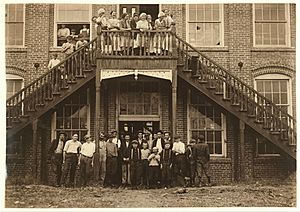
Cumberland County's population exploded in the post-World War II years, with its 43% increase in the 1960s the largest in any of North Carolina's 100 counties. Construction was fast-paced as shopping developments and suburban subdivisions began to spread outside the Fayetteville city limits toward Fort Bragg and Pope Air Force Base. The Fayetteville and Cumberland County school systems moved toward integration gradually, beginning in the early 1960s; busing brought about wider-scale student integration in the 1970s.
Segregation of public facilities continued. Civil rights marches and sit-ins, with students from Fayetteville State Teachers College (now Fayetteville State University) at the forefront, led to the end of whites-only service at restaurants and segregated seating in theaters. Politics changed. Blacks and women gained office in significant numbers, from the late 1960s and on into the early 1980s.
The Vietnam Era was a time of change in the Fayetteville area. Fort Bragg did not send many large units to Vietnam, but from 1966 to 1970, more than 200,000 soldiers trained at the post before leaving for the war. This buildup stimulated area businesses. Anti-war protests in Fayetteville drew national attention because of Fort Bragg, in a city that generally supported the war. Anti-war groups invited the actress and activist Jane Fonda to Fayetteville to participate in three anti-war events.
To combat the dispersal of suburbanization, Fayetteville has worked to redevelop its downtown through various revitalization projects; it has attracted large commercial and defense companies such as Purolator, General Dynamics and Wal-Mart Stores and Distribution Center. Development of the Airborne & Special Operations Museum, Fayetteville Area Transportation Museum, Fayetteville Linear Park, and Fayetteville Festival Park, which opened in late 2006, have added regional attractions to the center.
In the first decade of the 21st century, the towns and rural areas surrounding Fayetteville had rapid growth. Suburbs such as Hope Mills, Raeford and Spring Lake had increases in population.
In 2005, Congress passed the Base Realignment and Closure (BRAC) Act, resulting in several new commands relocating to Fort Bragg. These include the U.S. Army Forces Command (FORSCOM) and U.S. Army Reserve Command, both of which relocated from Fort McPherson in Atlanta. More than 30,000 people were expected to relocate to the area with associated businesses and families. FORSCOM awards over $300 billion in contracts annually.
In the November/December 2009 issue of Where to Retire, the magazine named Fayetteville as one of the best places to retire in the United States for military retirements.
On or about 11 December 2015, Fayetteville unveiled the Guinness World Record for the biggest Christmas stocking, weighing approx. 1600 lbs. and measuring 74.5'x139'.
Fort Bragg and Pope Army Airfield
Fort Bragg and Pope Army Airfield Field are in the northern part of the city of Fayetteville.
Several U.S. Army airborne units are stationed at Fort Bragg, most prominently the XVIII Airborne Corps HQ, the 82nd Airborne Division, and the United States Army Special Operations Command.
Fort Bragg was the home of the Field Artillery at the onset of World War II. All the Army's artillery units east of the Mississippi River were based at the post, about 5,000 men in all. Soldiers tested the Army's new bantam car, which was soon to be known as the Jeep, although most of the power to move artillery still came from horses and burros. On September 12, 1940, the Army contracted to expand the post, bringing the 9th Infantry Division to Fort Bragg.
The mission of Pope Field is to provide airlift to American armed forces and to humanitarian missions flown all over the world. Pope Field particularly provides air transportation for the 82nd Airborne, among other airborne units on Fort Bragg.
All of Pope's fighter jet squadrons have been relocated to Moody AFB, Georgia. The main entity at Pope are now the Air Force Reserves, although they still have a small amount of active personnel.
In September 2008, Fayetteville annexed 85% of Ft. Bragg, bringing the population of the city to 206,000. Ft. Bragg retains its own police, fire, and EMS services. Fayetteville hopes to attract large retail businesses to the area using the new population figures.
Sanctuary community for military families
On September 5, 2008, Cumberland County announced it was the "World's First Sanctuary for Soldiers and Their Families"; it marked major roads with blue and white "Sanctuary" signage. Within the county, soldiers were to be provided with local services, ranging from free childcare to job placement for soldiers' spouses.
Five hundred volunteers have signed up to watch over military families. They were recruited to offer one-to-one services; member businesses will also offer discounts and preferential treatments. Time magazine recognized Fayetteville for its support of military families and identified it as "America's Most Pro-Military Town".
National Register of Historic Places
Geography
The city limits extend west to the Hoke boundary. It is bordered on the north by the town of Spring Lake.
According to the United States Census Bureau, Fayetteville has a total area of 147.7 square miles (382.6 km2), of which 145.8 square miles (377.7 km2) is land and 1.9 square miles (4.8 km2) is water. The total area is 1.926% water.
Topography
Fayetteville is in the Sandhills of North Carolina, which are between the coastal plain to the southeast and the Piedmont to the northwest. The city is built on the Cape Fear River, a 202-mile-long (325 km) river that originates in Haywood and empties into the Atlantic Ocean. Carver's Falls, measuring 150 feet (46 m) wide and two stories tall, is on Carver Creek, a tributary of the Cape Fear, just northeast of the city limits.
Climate
Fayetteville is located in the humid subtropical climate (Köppen climate classification Cfa) zone, with mostly moderate temperatures year round. Winters are mild, but can get cool with snow occurring a few days per year. Summers are hot with levels of humidity which can cause spontaneous thunderstorms and rain showers. Temperature records range from −5 °F (−21 °C) on February 13, 1899 to 110 °F (43 °C) on August 21, 1983, which was the highest temperature ever recorded in the State of North Carolina. On April 16, 2011, Fayetteville was struck by an EF3 tornado during North Carolina's largest tornado outbreak. Surrounding areas such as Sanford, Dunn and Raleigh were also affected.
| Climate data for Fayetteville, North Carolina (1981–2010 normals) | |||||||||||||
|---|---|---|---|---|---|---|---|---|---|---|---|---|---|
| Month | Jan | Feb | Mar | Apr | May | Jun | Jul | Aug | Sep | Oct | Nov | Dec | Year |
| Record high °F (°C) | 81 (27) |
85 (29) |
97 (36) |
96 (36) |
102 (39) |
105 (41) |
107 (42) |
110 (43) |
106 (41) |
101 (38) |
88 (31) |
86 (30) |
110 (43) |
| Mean daily maximum °F (°C) | 52.7 (11.5) |
56.4 (13.6) |
64.4 (18.0) |
73.5 (23.1) |
80.5 (26.9) |
87.4 (30.8) |
90.3 (32.4) |
88.2 (31.2) |
82.8 (28.2) |
73.7 (23.2) |
65.3 (18.5) |
55.6 (13.1) |
72.6 (22.6) |
| Daily mean °F (°C) | 41.6 (5.3) |
44.6 (7.0) |
51.7 (10.9) |
60.3 (15.7) |
68.5 (20.3) |
76.7 (24.8) |
80.3 (26.8) |
78.6 (25.9) |
72.5 (22.5) |
61.9 (16.6) |
52.9 (11.6) |
44.3 (6.8) |
61.2 (16.2) |
| Mean daily minimum °F (°C) | 30.5 (−0.8) |
32.8 (0.4) |
39.0 (3.9) |
47.2 (8.4) |
56.6 (13.7) |
66.1 (18.9) |
70.4 (21.3) |
69.0 (20.6) |
62.2 (16.8) |
50.0 (10.0) |
40.5 (4.7) |
33.0 (0.6) |
49.8 (9.9) |
| Record low °F (°C) | −2 (−19) |
−5 (−21) |
14 (−10) |
20 (−7) |
32 (0) |
40 (4) |
51 (11) |
46 (8) |
28 (−2) |
21 (−6) |
15 (−9) |
2 (−17) |
−5 (−21) |
| Average precipitation inches (mm) | 3.64 (92) |
3.16 (80) |
3.83 (97) |
3.06 (78) |
3.32 (84) |
4.42 (112) |
5.37 (136) |
5.56 (141) |
4.13 (105) |
3.03 (77) |
2.94 (75) |
2.96 (75) |
45.42 (1,154) |
| Average snowfall inches (cm) | 0.4 (1.0) |
0.2 (0.51) |
0.2 (0.51) |
0.0 (0.0) |
0.0 (0.0) |
0.0 (0.0) |
0.0 (0.0) |
0.0 (0.0) |
0.0 (0.0) |
0.0 (0.0) |
0.0 (0.0) |
0.2 (0.51) |
1.0 (2.5) |
| Average precipitation days (≥ 0.01 in) | 10.8 | 9.2 | 9.5 | 8.0 | 8.9 | 9.8 | 11.6 | 10.8 | 8.2 | 7.4 | 7.3 | 9.8 | 111.3 |
| Average snowy days (≥ 0.1 in) | 0.1 | 0.1 | 0 | 0 | 0 | 0 | 0 | 0 | 0 | 0 | 0 | 0.1 | 0.3 |
| Source: NOAA | |||||||||||||
Demographics
| Historical population | |||
|---|---|---|---|
| Census | Pop. | %± | |
| 1790 | 1,536 | — | |
| 1820 | 3,532 | — | |
| 1830 | 2,868 | −18.8% | |
| 1840 | 4,285 | 49.4% | |
| 1850 | 4,646 | 8.4% | |
| 1860 | 4,790 | 3.1% | |
| 1870 | 4,660 | −2.7% | |
| 1880 | 3,485 | −25.2% | |
| 1890 | 4,222 | 21.1% | |
| 1900 | 4,670 | 10.6% | |
| 1910 | 7,045 | 50.9% | |
| 1920 | 8,877 | 26.0% | |
| 1930 | 13,049 | 47.0% | |
| 1940 | 17,428 | 33.6% | |
| 1950 | 34,715 | 99.2% | |
| 1960 | 47,106 | 35.7% | |
| 1970 | 53,510 | 13.6% | |
| 1980 | 59,507 | 11.2% | |
| 1990 | 112,948 | 89.8% | |
| 2000 | 121,015 | 7.1% | |
| 2010 | 200,782 | 65.9% | |
| 2020 | 208,501 | 3.8% | |
| 2023 (est.) | 209,749 | 4.5% | |
| U.S. Decennial Census 2010 2020 |
|||
2020 census
| Race | Number | Percentage |
|---|---|---|
| Black or African American (non-Hispanic) | 87,193 | 41.82% |
| White (non-Hispanic) | 71,917 | 34.49% |
| Native American | 1,993 | 0.96% |
| Asian | 6,487 | 3.11% |
| Pacific Islander | 980 | 0.47% |
| Other/Mixed | 13,662 | 6.55% |
| Hispanic or Latino | 26,269 | 12.6% |
As of the 2020 United States census, there were 208,501 people, 82,087 households, and 46,624 families residing in the city.
2010 census
As of the census of 2010, there were 200,564 people, 78,274 households, and 51,163 families residing in the city. The population density was 1,401 people per square mile (541.1/km2). There were 87,005 housing units at an average density of 230.3 units/km2 (596.3 persons/sq mi). The racial composition of the city was 45.7% White, 41.9% Black or African American, 2.6% Asian American, 1.1% Native American, 0.4% Native Hawaiian or Other Pacific Islander, 3.3% some other race, and 4.9% two or more races. 10.1% of the population were Hispanic or Latino of any race.
There were 78,274 households, out of which 36.7% had children under the age of 18 living with them, 41.3% were headed by married couples living together, 19.5% had a female householder with no husband present, and 34.6% were non-families. 28.7% of all households were made up of individuals, and 7.3% were someone living alone who was 65 years of age or older. The average household size was 2.45, and the average family size was 3.02.
In the city the population was spread out, with 25.8% under the age of 18, 14.4% from 18 to 24, 28.5% from 25 to 44, 21.5% from 45 to 64, and 9.7% who were 65 years of age or older. The median age was 29.9 years. For every 100 females, there were 93.6 males. For every 100 females age 18 and over, there were 90.5 males.
In 2013, the estimated median annual income for a household in the city was $44,924, and the median income for a family was $49,608. Male full-time workers had a median income of $37,371 versus $32,208 for females. The per capita income for the city was $23,362. 18.4% of the population and 16.2% of families were below the poverty line. 27.1% of those under the age of 18 and 9.8% of those 65 and older were living below the poverty line.
On September 30, 2005, Fayetteville annexed 27 square miles (70 km2) and 46,000 residents. Some affected residents and developers challenged the annexation in the courts, but were ultimately unsuccessful. The exception was the Gates Four neighborhood which won its case against annexation despite the annexation of all surrounding neighborhoods.
Religion
Founded in Wade in 1758, Old Bluff Presbyterian Church is one of the oldest churches in the Upper Cape Fear Valley. The fourth Sunday of September each year is the annual Old Bluff Reunion; it is open to the public. Bluff Presbyterian Church maintains a detailed history at its website.
Hundreds of houses of worship have been established in and around Cumberland County, including Catholic, Baptist, Pentecostal, Methodist and Presbyterian churches, which have the largest congregations. Fayetteville is also home to Congregation Beth Israel, formed in 1910 by the Jewish families of Fayetteville.
Fayetteville is home to St. Patrick Church, the oldest Catholic parish in the state, dating back to the 18th century.
The Masjid Omar ibn Sayyid mosque was named after Omar ibn Said, an African Muslim who was jailed as a fugitive slave and sold in Fayetteville in the 19th century. Visitors to the mosque can find historical information about him and the Muslim community. Additionally, a historical marker to ibn Said was cast along Murchison Road in 2010, the first roadside in North Carolina to recognize a Muslim.
Economy
Fort Liberty is the backbone of the county's economy. Fort Liberty and Pope Field pump about $4.5 billion a year into the region's economy, making Fayetteville one of the best retail markets in the country. Fayetteville serves as the region's hub for shops, restaurants, services, lodging, health care, and entertainment.
As of March 2019, Fayetteville reflected an unemployment rate of 5.2%, which is higher than the national average of 3.8% and the North Carolina average of 4%.
Top employers
According to the Fayetteville 2018 Comprehensive Annual Financial Report, the top employers in the city are:
| # | Employer | # of Employees |
|---|---|---|
| 1 | Department of Defense (Civilian) (Fort Liberty) | 14,036 |
| 2 | Cape Fear Valley Health System | 7,000 |
| 3 | Cumberland County Public School System | 6,042 |
| 4 | Wal-Mart | 3,956 |
| 5 | Goodyear Tire and Rubber Company | 2,500 |
| 6 | Cumberland County Government | 2,095 |
| 7 | Veterans Administration | 2,000 |
| 8 | City of Fayetteville | 1,776 |
| 9 | Fayetteville Technical Community College | 1,383 |
| 10 | Fayetteville State University | 885 |
Defense industry
The Fayetteville area has a large and growing defense industry and was ranked in the top five areas in US for 2008, 2010, 2011 by a trade publication. Eight of the ten top American defense contractors are located in the area, including Lockheed Martin, Boeing, Northrop Grumman, General Dynamics, and L-3 Communications. The city hosts Partnership for Defense Initiatives (PDI), a trade association promoting defense contractors.
Arts and culture
An October 2023 study released by Americans for the Arts, (AFTA) found that nonprofit arts and culture organizations in Fayetteville and Cumberland County created $72.2 million in total economic activity in 2022, supported over 1100 jobs, provided $44.1 million in personal income to residents and generated $9.5 million in local, state and federal tax revenue. At an April 2024 event the Arts Council of Fayetteville/Cumberland County announced that arts and cultural activities drew more than 900,000 visitors to the region.
Points of interest
Festivals
- Fayetteville Dogwood Festival
- International Folk Festival
- Juneteenth
- 4th Fridays
Historic sites
- Cool Spring Tavern
- Evans Metropolitan AME Zion Church
- Ellerslie Plantation
- The first Golden Corral
- Hay Street United Methodist Church
- Heritage Square
Libraries
- Cumberland County Libraries
Museums
- Airborne & Special Operations Museum
- Fascinate-U Children's Museum
- Museum of the Cape Fear Historical Complex
Parks and recreation
- Cape Fear Botanical Garden
- Freedom Memorial Park
- Mazerick Park
Shopping
Theaters and arenas
- Crown Coliseum
- Cape Fear Regional Theatre
Clubs and organizations
- Boys & Girls Clubs of Cumberland County
- The Woman's Club of Fayetteville
Arts & Culture Organizations
- Arts Council of Fayetteville/Cumberland County
- Cape Fear Ballroom Dancers
- Cape Fear Botanical Garden
- Cape Fear Regional Theatre
- Cape Fear Studios
- Community Concerts
- Cool Springs Downtown District
- Cumberland Choral Arts
- Dance Theatre of Fayetteville
- Fayetteville Artists Guild
- Fayetteville Symphony Orchestra
- The Gilbert Theater
- Sweet Tea Shakespeare
- Tarheel Quilters Guild
- Umoja Group
Sports
| Club | Sport | League | Venue | Established | Championships |
|---|---|---|---|---|---|
| Fayetteville Woodpeckers | Baseball | Carolina League | Segra Stadium | 2017 | 1 |
| Fayetteville Marksmen | Ice hockey | SPHL | Crown Coliseum | 2002 | 1 |
Education
Public schools
Cumberland County Schools' headquarters are located in Fayetteville. CCS operates a total of 87 schools: 53 elementary schools, 16 middle schools, 15 high schools and 9 Alternative and Specialty schools, including 1 year-round classical, 1 evening academy, 1 web academy and 2 special schools. Cumberland County Schools is the fourth-largest school system in the state and 78th-largest in the country.
Cumberland County Schools serves most areas of Fayetteville for grades PK-12. The Department of Defense Education Activity (DoDEA) operates public schools on Fort Liberty for PK-8, but for high school Fort Liberty students attend local public schools in their respective counties.
High schools (grades 9–12)
- Cape Fear High School – School of Agricultural & Natural Sciences Academy (9–12)
- Douglas Byrd High School – Finance Academy & Ford Partnerships for Advanced Studies (9–12)
- Ezekiel Ezra "E.E." Smith High School – Academies of Math & Science and Fire Science (9–12)
- Jack Britt High School – Academy of Integrated Systems of Technology and Applied Engineering (9–12)
- Pine Forest High School – Academies of Emergency Medical Science & Information Technology (9–12)
- Seventy-First High School – School of Arts (9–12)
- Terry Sanford High School – Global Studies Academy (9–12)
- Westover High School – Academies of Health and Engineering (9–12)
- South View High School – International Baccalaureate (9–12)
- Gray's Creek High School – Academy of Information Technology (9–12)
Specialty schools
- Cross Creek Early College High School (9–12)
- Cumberland International Early College High School (9–12)
- Massey Hill Classical High School (9–12)
- Cumberland Polytechnic High School (9–12)
Private schools
- Berean Baptist Academy (Pre-K–12)
- Fayetteville Academy
- Fayetteville Christian School (Pre-K–12)
- Northwood Temple Academy
- Village Christian Academy
- Trinity Christian School (K–12)
Colleges and universities
- Carolina College of Biblical Studies
- Manna University (formerly Grace College of Divinity)
- Fayetteville State University
- Fayetteville Technical Community College
- Methodist University
- Shaw University Satellite Campus
Media
Newspapers
- The Fayetteville Observer
- Up & Coming Weekly Local community newspaper
- The Voice
- The Fayetteville Press
- Acento Latino
- The Paraglide
Television stations
Fayetteville is part of and served by television stations in the Raleigh–Durham television market.
- FayTV7 (Spectrum Channel 7) City of Fayetteville's Government Access Channel
Radio stations
- 88.3 FM WUAW Various Genres
- 88.7 FM WRAE Religious Music
- 89.3 FM WZRI Christian Contemporary Music
- 90.1 FM WCCE Christian Contemporary Music
- 91.1 FM WYBH Traditional Christian Music/Teaching/BBN
- 91.9 FM WFSS Public Radio
- 95.7 FM WKML Country
- 96.5 FM WFLB Classic Hits
- 98.1 FM WQSM Top 40
- 99.1 FM WZFX Mainstream Urban (Hip Hop and R&B)
- 102.3 FM WFVL Christian Contemporary/ K-Love
- 103.5 FM WRCQ Rock
- 104.5 FM WCCG Mainstream Urban (Hip Hop and R&B)
- 105.7 FM WCLN-FM Southern Gospel Music
- 106.9 FM WMGU Urban Adult Contemporary (Adult's R&B)
- 107.3 FM WKFV Contemporary Christian/K-Love
- 107.7 FM WUKS Urban Adult Contemporary (Smooth R&B)
- 640 AM WFNC News/talk
- 1230 AM WFAY Country
- 1450 AM WMRV Classic Rock
- 1490 AM WAZZ Top 40
- 1600 AM WIDU Black Gospel/Talk
Infrastructure
Major highways
Interstate highways
 I-95
I-95 I-95 Bus.
I-95 Bus.




 I-295 / Future I-295
I-295 / Future I-295
U.S. highways
 US 13
US 13 US 301
US 301 US 401
US 401
State highways
 NC 24
NC 24 NC 53
NC 53 NC 59
NC 59 NC 87
NC 87 NC 162
NC 162 NC 210
NC 210 NC 295 (component highway for I-295)
NC 295 (component highway for I-295)
Other highways
- All American Freeway
- Martin Luther King Jr. Freeway
Air transportation
Fayetteville Regional Airport is served by five regional carriers that provide daily and seasonal passenger services to three major airline hubs within the United States. An additional regional carrier and several fixed-base operators offer further services for both passenger and general aviation operations. Landmark Aviation also provides services for passenger and general aviation traffic at the Fayetteville Regional Airport.
Public transportation
The Fayetteville Area System of Transit (FAST) serves the Fayetteville and Spring Lake regions, with ten bus routes and two shuttle routes. FAST operates thirteen fixed bus routes within the city of Fayetteville. Service is between the hours of 5:45 am and 10:30 pm on weekdays, with reduced hours on Saturdays and no Sunday service. Most routes begin and end at the Transfer Center at 147 Old Wilmington Road in Fayetteville. Other transfer points are located at University Estates, Cross Creek Mall, Veterans Administration Medical Center, Bunce and Cliffdale Rds and Cape Fear Valley Medical Center.
Passenger rail
The Atlantic Coast Line Railroad Station, built in 1911, provides daily Amtrak service with northbound and southbound routes leading to points along the East Coast.
Notable people
Sister city
Fayetteville has one sister city, as designated by Sister Cities International:
See also
 In Spanish: Fayetteville (Carolina del Norte) para niños
In Spanish: Fayetteville (Carolina del Norte) para niños



